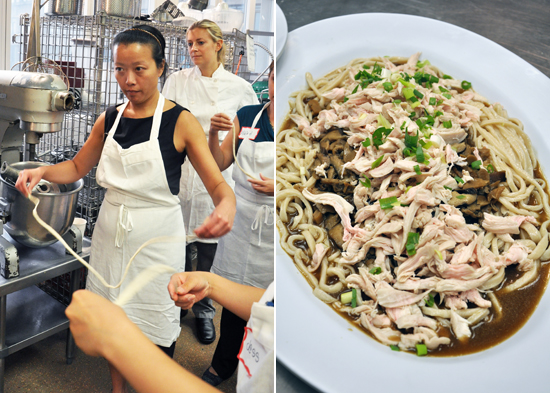In Beijing’s noodle shops, noodle pullers transform a simple ball of dough into thousands of noodles simply by twisting and pulling it apart with their fingers. It takes years to master their technique and swift and fluid movements. But in Lillian Chou’s Beijing Noodle Making recreational class at ICE, I discovered that making Asian-style noodles from scratch can be very easy.
I didn’t quite manage to pull them from a single lump of dough, but Chef Chou taught the class how to stretch and bounce strips of dough into long, thing noodles. The students in the class took our hand-cut and twisted noodles and managed to make them into a variety of delicious dishes with her guidance. Along the way, she shared the tips and techniques she has picked up while living in Beijing. Here are a few highlights:

Don’t Overdo the Meat: Thinking of meat as a seasoning, rather than a main component, can be a great way to add a richer flavor without overpowering vegetables (and save some money). For Tian Tian Cao Mian, we used only a small handful of ground pork in a dish that fed four.
Trust the Dough: Noodle dough is very forgiving. You don’t need to fuss and fret. You can always add more flour and water as needed to get a soft, silky dough. Simply letting it rest after kneading will give the dough a chance to relax and make it easier to work with.
Foreign Flour: Flours in China are silkier and whiter than American flours. To recreate similar flour for noodles at home, mix a three-to-one ratio of bread flour to cake flour.
Waste Not, Want Not: An easy way to peel fresh ginger is to use the edge of a spoon. There will be less waste than cutting away the outer peel with a knife.
Size Matters: When you cut all the components of a dish to a similar size you will get a little bit of everything in each forkful (or chopstick-ful). That way you experience the contrast of textures of crunchy and soft ingredients in every bite. While our noodles were not as thin or uniform as those from a package, they were beautiful in their own, rustic way. After a little (or maybe a lot) of practice, I’m sure my noodles will match a master noodle puller’s.
Interested in learning how to make more authentic Chinese dishes? Check out the recreational classes coming up at ICE!



